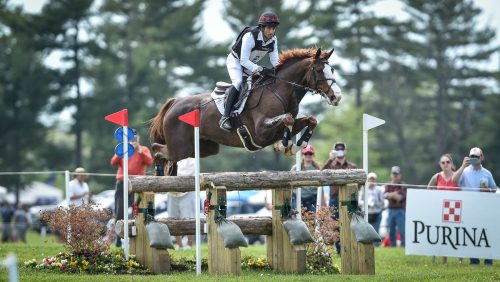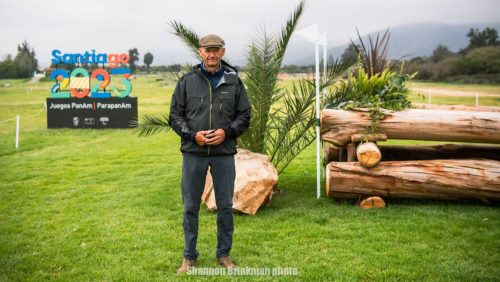Our columnist believes that if you achieve these eight goals you’ll improve your future performance.
Although 2010 is just an artificial number on a calendar, it’s still the start of a new decade and an appropriate take-off point for new resolutions. I absolutely guarantee that event riders who manage to achieve some of the goals I’m about to list will ride more effectively and will achieve greater satisfaction in their chosen sport.
Each one of these goals is attainable for riders who aren’t badly handicapped with medical issues. They aren’t necessarily easy goals, but they are all achievable.
Goal No. 1: Try to develop the correct horse-rider match-up for you. This directive may be hard, because you already love the one you have, but try to make an honest assessment. “Is this horse the horse I need to achieve the goals I want to achieve?”
Here are a couple of examples. If you need confidence on cross-country, and your horse calmly and bravely marches out there and jumps those fences, doesn’t rush and rarely refuses, then that’s a great match-up. But if he spooks, races, quits and scares you, maybe it’s not so great a mix ‘n’ match.
If you’re struggling to acquire an independent seat (more on this topic later) does your horse let you make mistakes, or does he overreact to your bouncing, thus making your job infinitely more difficult? Be as honest as you can about Goal No. 1.
Goal No. 2: Get yourself and your horse in better physical condition so that you aren’t a menace on the highways either to yourself or to him.
Go to any event and stand where you can watch the riders about three quarters of the way around the cross-country course. Many will be doing just fine, thanks very much, but some will look like The Addams Family character, Lurch. And not just lurching a little but lurching a lot—and lurching while panting, wheezing, gasping and bobbing about. This exhausted state is not conducive to safe riding. Be safe; get fit.
Goal No. 3: (Related to No. 2) Learn how to safely, securely and effectively gallop a horse out in the open over hilly, undulating terrain. I’ve heard the saying that “galloping is one-third technique, two-thirds fitness,” so that’s why I’ve listed this after Goal No. 2.
Shorten those stirrups, and start by trotting in the arena without posting. Then add some canter sets. Then take it outdoors. You don’t have to be able to fly 4 miles of Maryland Hunt Cup, but you should absolutely be able to maintain your galloping position around your cross-country courses.
ADVERTISEMENT
Goal No. 4: Develop an independent dressage seat. Jack Le Goff used to preach this as Goal No. 1, the basic prerequisite to becoming a good rider.
Think of your horse as a horizontally built shock wave producing machine. Think of yourself as a vertically built shock wave absorbing machine. When his movements are in harmony at the trot and canter with your movements, the bouncing, jouncing and flailing about disappears. Your hands have the chance to become quiet, feeling and steady. So do your lower legs. But until you achieve core body strength so that you can sit the gaits without posting at the trot or hovering at the canter, no true harmony is possible. Goal No. 4 is a big, important goal.
Goal No. 5: Learn (and live) the dressage training scale. Use this easy pneumonic device: “Rachel sees Charlie; I see Charlie.” R=rhythm. S=suppleness. C=contact. I=impulsion. S=straightness. C=collection.
Dressage experts gathered to devise and codify a system of training that makes sense, is sequential and avoids undue stress, tension and anxiety from the equine partner.
First comes rhythm at the walk, trot and canter. Then comes suppleness, usually with “Losgelassenheit” as a component piece. Use Google to study this word and concept. Next comes the back to front contact derived from rhythm and suppleness. And so on up the scale, always being willing to drop back to re-solidify the basics when things go wrong.
Goal No. 6: Learn about distances between fences, and learn how to accurately walk distances. Let’s assume that a show jumping course designer has three related distances on her stadium course. One is an oxer to a vertical 58 feet apart. Another is a vertical to an oxer set at 24 feet. The third is an oxer to an oxer set at 48 feet.
Can you walk those distances without a coach and ascertain, within a foot or two, how far apart those jumps are set? And, having done that, can you describe what those distances mean in terms of what you and your horse are going to do about it later in the day?
Learn to walk all kinds of distances and learn what they mean. Hang around the show jumping arena until one strides, two strides from a canter, from a trot, bounces from a trot, all these things are as familiar to you as turning on your car.
Goal No. 7: Strive to look and ride like Beezie Madden over fences! OK, just a joke. But it’s not entirely a joke because correct technique is learnable through practice. Find some photographs of jumping riders whose style you admire, cut them out and study them. Place photos of yourself next to these role model photos, and study the differences. Study the “physics” of jumping, the lines and angles.
Good technicians don’t leap up the neck, lie on the horse’s neck, look down, or let their lower legs slip back toward the horse’s hipbones. Their eyes and chins are up, their legs are underneath them, their backs are flat, and their hands and arms are allowing the horse to make a bascule over the fence. If the horse were to suddenly disappear, the good riders would land on their feet.
ADVERTISEMENT
Practice, practice, practice, with someone on the ground to help you achieve stability and security. Practice to develop a better, more adjustable canter, as this will lead to a better eye for a distance. It’s all a matter of making the correct basics your way of doing business.
Goal No. 8: Expand the emotional trait of courage. Of all the traits needed for eventing, courage is the most important one of all, the prerequisite for everything else. “But,” you ask, “how do I get brave if I’m not already brave?” You use the stepping stone approach. Here’s a mantra for schooling either the young horse or the green rider. “Boldness comes from confidence. Confidence comes from success. So guarantee success.”
How do we guarantee success? Here’s where all the preceding goals mesh and interact. First, you now have the right horse for you. He’s able to do the things you want to do, in more or less the way you want to do them.
Second, you (and he) are physically fit, tough and resilient and agile enough to do them. Why? Because you’ve stepped out of your comfort zone enough to get that way. You’ve hiked, swept the barn aisle, hauled hay bales, ridden a stationary bike, lifted weights, done pushups or sit-ups or chin-ups. You’ve made yourself into an athlete as part of Goal No. 2.
Third, because you’ve achieved Goal No. 3, you’re comfortable galloping at speed on bad terrain. Now we just have to throw in some appropriate jumps.
Fourth, because you’ve acquired an independent seat, you’re quite com-fortable on the back of the moving horse. Your body meshes with the movements of your horse’s body. Your Lurch look-a-like impression is a thing of the past.
Fifth and sixth, you’re able to achieve success because you’ve learned in a somewhat academic fashion how to achieve success. You know much about dressage and much about jumping. You aren’t a novice anymore; you’ve become a knowledgeable technician.
And seventh, you have a secure grasp of the fundamentals of secure jumping techniques.
So now you have all the tools needed to create success. With success comes confidence. You know you can do it. And from confidence flows boldness, just another word for courage! So you’ve achieved all eight goals.
It’s all a matter of taking the details one by one and turning each of those details into your own personal property. Then add them all together, and you’ll be on your way to being a brave, proficient event rider.
Denny Emerson rode on the 1974 World Championship gold-medal eventing team. He served as the U.S. Eventing Association president twice and won the USEA Wofford Cup for his lifetime dedication to eventing. At his Tamarack Hill Farm in South Strafford, Vt., and Southern Pines, N.C., he trains horses and riders and stands stallions. An original Between Rounds contributor, Emerson began writing his column in 1989.















